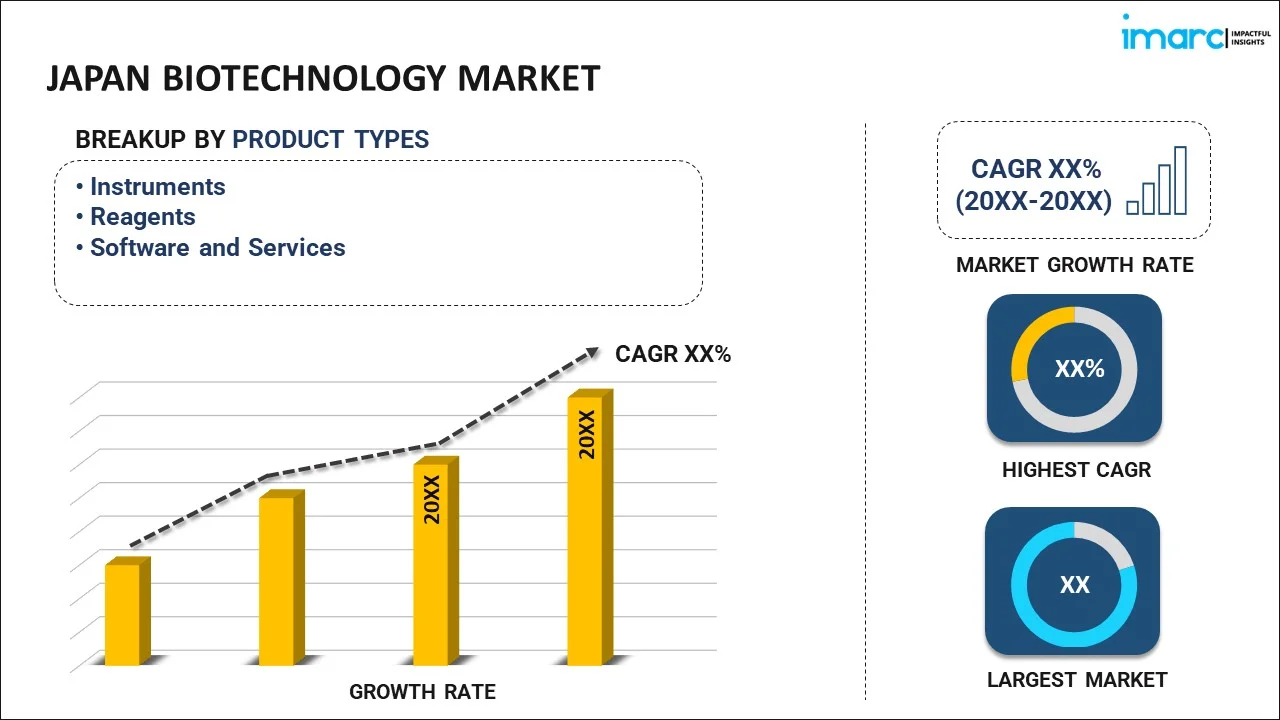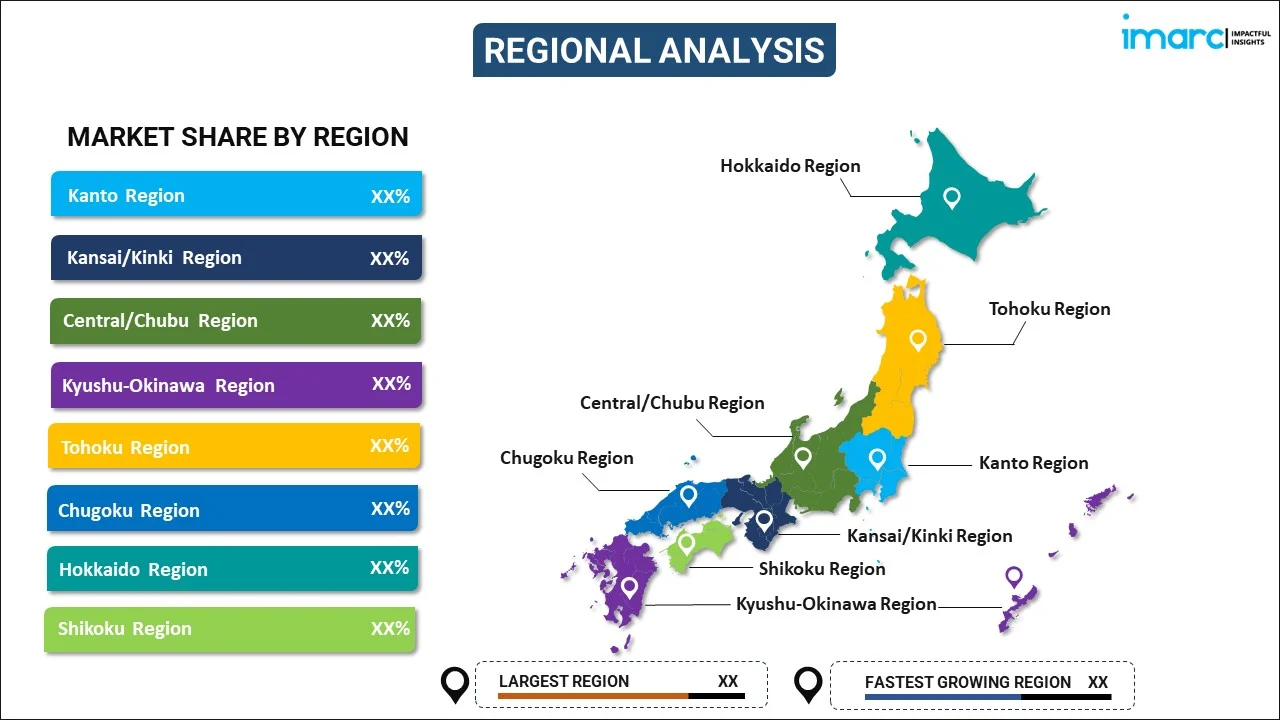
Japan Biotechnology Market Report by Product Type (Instruments, Reagents, Software and Services), Technology (Nanobiotechnology, Tissue Engineering and Regeneration, DNA Sequencing, Cell-Based Assays, Fermentation, PCR Technology, Chromatography, and Others), Application (Healthcare, Food and Agriculture, Natural Resources and Environment, Industrial Processing, Bioinformatics, and Others), and Region 2025-2033
Market Overview:
Japan biotechnology market size reached USD 32.2 Billion in 2024. Looking forward, IMARC Group expects the market to reach USD 63.3 Billion by 2033, exhibiting a growth rate (CAGR) of 7.3% during 2025-2033. The increasing demand for personalized therapies, including biomarker discovery, pharmacogenomics, and precision medicine, which tailors medical treatments to individual patient genetics, is primarily driving the market.
|
Report Attribute
|
Key Statistics
|
|---|---|
|
Base Year
|
2024 |
|
Forecast Years
|
2025-2033
|
|
Historical Years
|
2019-2024
|
| Market Size in 2024 | USD 32.2 Billion |
| Market Forecast in 2033 | USD 63.3 Billion |
| Market Growth Rate (2025-2033) | 7.3% |
Biotechnology is a multidisciplinary field that combines biology and technology to harness living organisms, cellular processes, and biomolecules for various applications. It encompasses a wide range of scientific techniques and tools to manipulate, modify, and enhance living organisms or their components to create products or solve problems. In agriculture, biotechnology has led to the development of genetically modified crops that resist pests, require fewer pesticides, and enhance nutritional content. In medicine, it has revolutionized healthcare by enabling the production of biopharmaceuticals, gene therapies, and personalized medicine, leading to more effective treatments for diseases. Biotechnology also plays a crucial role in environmental conservation, with applications in bioremediation and wastewater treatment. Moreover, biotechnology contributes to the production of biofuels, the creation of novel materials, and advancements in biomanufacturing processes. It has profound implications for the future, with potential breakthroughs in fields like synthetic biology, regenerative medicine, and sustainable agriculture, offering solutions to some of humanity's most pressing challenges.
Japan Biotechnology Market Trends:
The biotechnology market in Japan is rapidly evolving, with several interconnected drivers fueling its growth. Firstly, the increasing regional population, combined with rising healthcare needs, has created a pressing demand for innovative medical solutions. Consequently, biotechnology companies are driven to develop novel therapies, diagnostics, and vaccines to address these healthcare challenges. Moreover, advancements in genetic research have unlocked new opportunities in personalized medicine. This, in turn, has sparked significant investments in biotechnology as companies strive to harness the potential of precision medicine to tailor treatments to individual patients. Furthermore, environmental concerns and the push for sustainable practices have driven the development of biotechnology solutions for agriculture and biofuels. In addition to this, the convergence of artificial intelligence and biotechnology has led to the emergence of bioinformatics and data-driven approaches in drug discovery and development. This synergy has accelerated research processes and expanded the scope of possibilities within the biotech sector. Lastly, regulatory support and incentives for biotechnology R&D have played a crucial role in fostering innovation and attracting investment. As a result, the biotechnology market in Japan continues to thrive, driven by these interconnected factors that promise to shape the future of healthcare, agriculture, and sustainability.
Japan Biotechnology Market Segmentation:
IMARC Group provides an analysis of the key trends in each segment of the market, along with forecasts at the country level for 2025-2033. Our report has categorized the market based on product type, technology, and application.
Product Type Insights:

- Instruments
- Reagents
- Software and Services
The report has provided a detailed breakup and analysis of the market based on the product type. This includes instruments, reagents, and software and services.
Technology Insights:
- Nanobiotechnology
- Tissue Engineering and Regeneration
- DNA Sequencing
- Cell-Based Assays
- Fermentation
- PCR Technology
- Chromatography
- Others
A detailed breakup and analysis of the market based on the technology have also been provided in the report. This includes nanobiotechnology, tissue engineering and regeneration, DNA sequencing, cell-based assays, fermentation, PCR technology, chromatography, and others.
Application Insights:
- Healthcare
- Food and Agriculture
- Natural Resources and Environment
- Industrial Processing
- Bioinformatics
- Others
The report has provided a detailed breakup and analysis of the market based on the application. This includes healthcare, food and agriculture, natural resources and environment, industrial processing, bioinformatics, and others.
Regional Insights:

- Kanto Region
- Kansai/Kinki Region
- Central/ Chubu Region
- Kyushu-Okinawa Region
- Tohoku Region
- Chugoku Region
- Hokkaido Region
- Shikoku Region
The report has also provided a comprehensive analysis of all the major regional markets, which include Kanto Region, Kansai/Kinki Region, Central/ Chubu Region, Kyushu-Okinawa Region, Tohoku Region, Chugoku Region, Hokkaido Region, and Shikoku Region.
Competitive Landscape:
The market research report has also provided a comprehensive analysis of the competitive landscape. Competitive analysis such as market structure, key player positioning, top winning strategies, competitive dashboard, and company evaluation quadrant has been covered in the report. Also, detailed profiles of all major companies have been provided.
Japan Biotechnology Market Report Coverage:
| Report Features | Details |
|---|---|
| Base Year of the Analysis | 2024 |
| Historical Period | 2019-2024 |
| Forecast Period | 2025-2033 |
| Units | Billion USD |
| Scope of the Report | Exploration of Historical Trends and Market Outlook, Industry Catalysts and Challenges, Segment-Wise Historical and Future Market Assessment:
|
| Product Types Covered | Instruments, Reagents, Software and Services |
| Technologies Covered | Nanobiotechnology, Tissue Engineering and Regeneration, DNA Sequencing, Cell-Based Assays, Fermentation, PCR Technology, Chromatography, Others |
| Applications Covered | Healthcare, Food and Agriculture, Natural Resources and Environment, Industrial Processing, Bioinformatics, Others |
| Regions Covered | Kanto Region, Kansai/Kinki Region, Central/ Chubu Region, Kyushu-Okinawa Region, Tohoku Region, Chugoku Region, Hokkaido Region, Shikoku Region |
| Customization Scope | 10% Free Customization |
| Post-Sale Analyst Support | 10-12 Weeks |
| Delivery Format | PDF and Excel through Email (We can also provide the editable version of the report in PPT/Word format on special request) |
Key Questions Answered in This Report:
- How has the Japan biotechnology market performed so far and how will it perform in the coming years?
- What has been the impact of COVID-19 on the Japan biotechnology market?
- What is the breakup of the Japan biotechnology market on the basis of product type?
- What is the breakup of the Japan biotechnology market on the basis of technology?
- What is the breakup of the Japan biotechnology market on the basis of application?
- What are the various stages in the value chain of the Japan biotechnology market?
- What are the key driving factors and challenges in the Japan biotechnology?
- What is the structure of the Japan biotechnology market and who are the key players?
- What is the degree of competition in the Japan biotechnology market?
Key Benefits for Stakeholders:
- IMARC’s industry report offers a comprehensive quantitative analysis of various market segments, historical and current market trends, market forecasts, and dynamics of the Japan biotechnology market from 2019-2033.
- The research report provides the latest information on the market drivers, challenges, and opportunities in the Japan biotechnology market.
- Porter's five forces analysis assist stakeholders in assessing the impact of new entrants, competitive rivalry, supplier power, buyer power, and the threat of substitution. It helps stakeholders to analyze the level of competition within the Japan biotechnology industry and its attractiveness.
- Competitive landscape allows stakeholders to understand their competitive environment and provides an insight into the current positions of key players in the market.
Need more help?
- Speak to our experienced analysts for insights on the current market scenarios.
- Include additional segments and countries to customize the report as per your requirement.
- Gain an unparalleled competitive advantage in your domain by understanding how to utilize the report and positively impacting your operations and revenue.
- For further assistance, please connect with our analysts.
 Inquire Before Buying
Inquire Before Buying
 Speak to an Analyst
Speak to an Analyst
 Request Brochure
Request Brochure
 Request Customization
Request Customization




.webp)




.webp)












